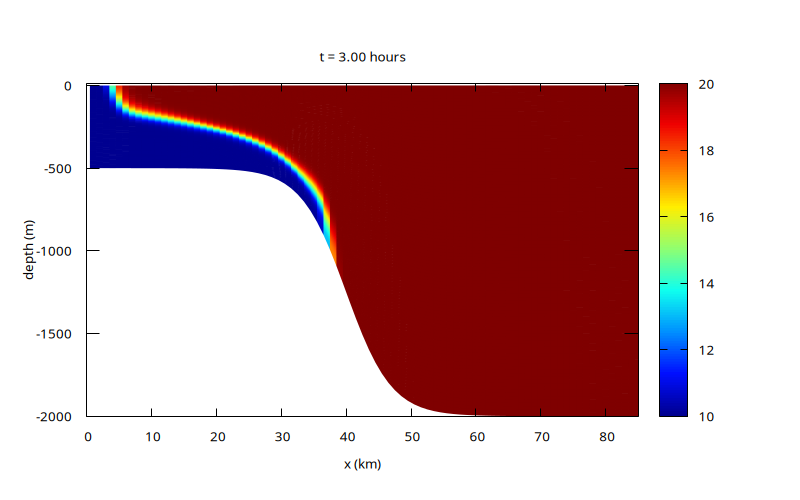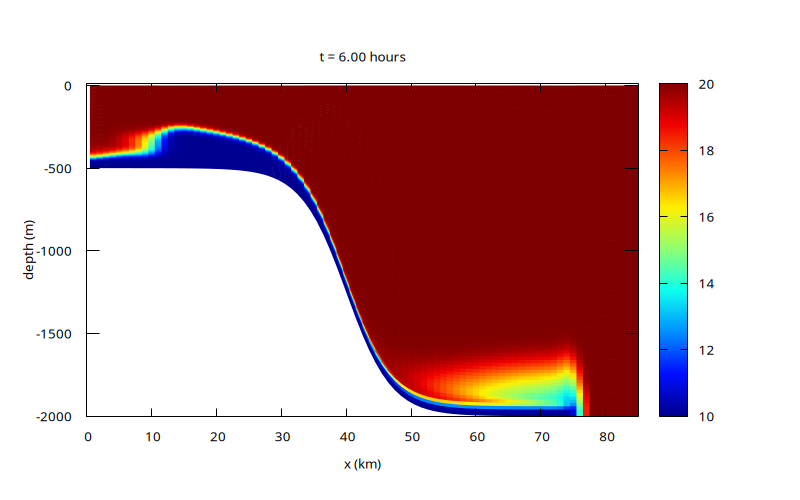/**
# Overflow
This test case was designed by [Ilicak et al., 2012](#ilicak2012),
section 4, to investigate the mixing properties of numerical schemes
in the case of "overflow" i.e. a denser fluid flowing down a sill or
continental slope.
Note that the test case is largely qualitative and is in particular
very sensitive to various sources of dissipation, including bottom
boundary conditions etc.
The evolution of the "temperature"/density field is illustrated in the
sequence below. The cool/dense fluid to the left is released at the
top of the slope and flows down. Although no explicit temperature
diffusion is prescribed, numerical diffusion leads to the formation of
a diffused plume in regions of high shear (the "head" of the flow).

The figures at $t=3$ and $t=6$ hours below agree closely with Figure
4.k and 4.l of [Petersen et al, 2015](#petersen2015).
{ width=100% }
{ width=100% }
The amount of mixing can be measured by looking at the evolution of
the Reference (or Resting) Potential Energy (RPE) as proposed by
[Ilicak et al, 2012](#ilicak2012). In the ideal case without any
numerically-induced mixing, the RPE should be conserved.
~~~gnuplot Evolution of the normalised reference potential energy
set xlabel 'Time (hours)'
set ylabel '(RPE - RPE(0))/RPE(0) x 10^5'
hour = 3600.
set xrange [0:12]
plot 'log' u ($1/hour):(-$3/$4*1e7) w l t ''
~~~
~~~gnuplot Evolution of the average rate of change of the reference potential energy
set ylabel 'dRPE/dt (Watts/m^2)'
set logscale y
L0 = 256e3
plot 'log' u ($1/hour):(abs($3)/$1/L0) w l t ''
~~~
~~~gnuplot Evolution of the Available Potential Energy (APE = PE - RPE).
set ylabel 'APE (Joules)'
unset logscale y
plot 'log' every 1 u ($1/hour):($5-$3) w l t ''
~~~
~~~gnuplot Evolution of the Kinetic Energy.
set ylabel 'KE (Joules)'
plot 'log' every 1 u ($1/hour):6 w l t ''
~~~
~~~gnuplot Evolution of the Total Energy KE + APE.
set ylabel 'Total Energy (Joules)'
unset logscale
plot 'log' every 10 u 1:($5-$3+$6) w l t ''
~~~
## Non-diffusive interface
This is the same setup but using a vertical remapping which preserves
the sharp temperature/density interface (i.e. the interface is treated
in a Lagrangian manner while the other layers are "Eulerian"). Note
that this is different from the two-layers isopycnal run of [Petersen
et al, 2015](#petersen2015) since here 20 layers are used (10 in each
"phase"), and so the vertical velocity profile is resolved.
